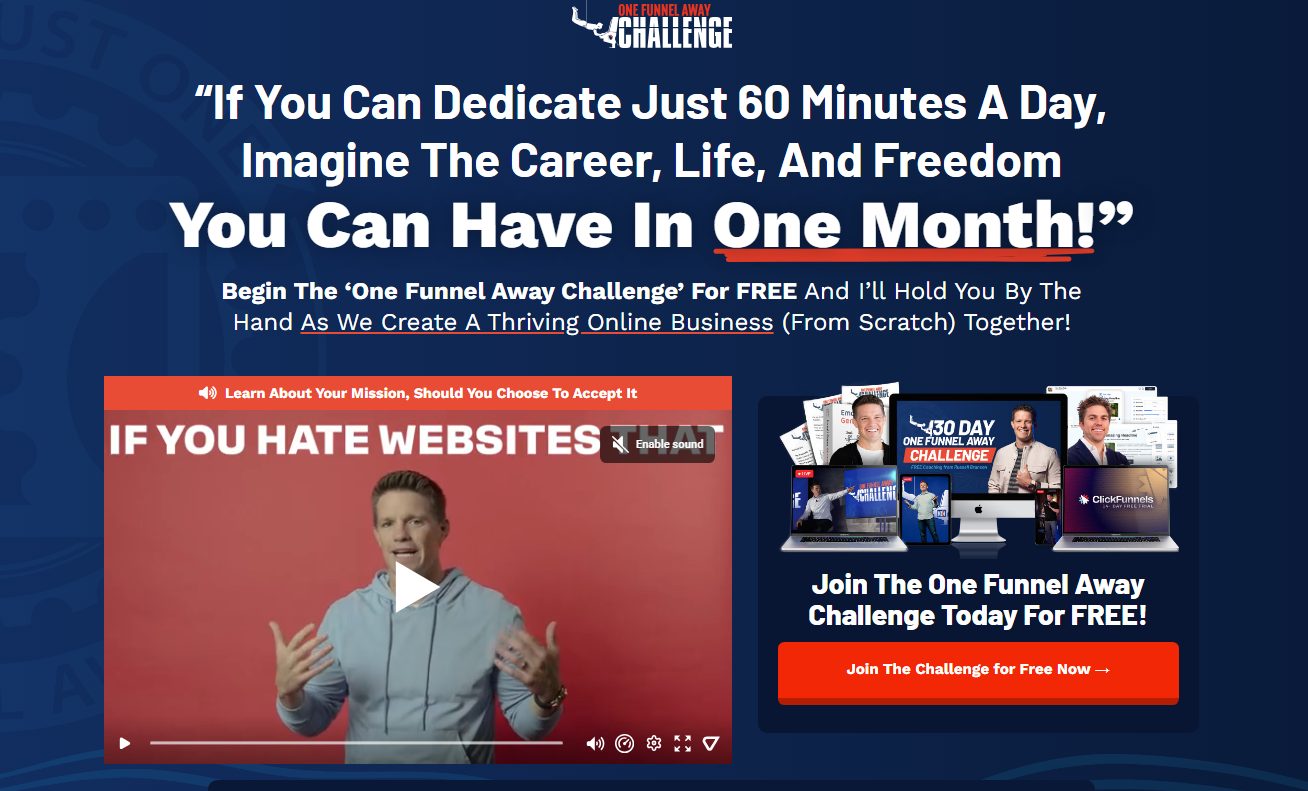There are plenty of gurus in the online sales world, and Russell Brunson (founder of ClickFunnels) is a prominent figure.
The Value Ladder is a sales method he developed that is particularly well-suited to sales funnels. However, it doesn’t work for every sales process, and some might find it too pushy.
Key Takeaways:
- The Value Ladder focuses on continuous, incremental upsells
- It follows a linear process that doesn’t necessarily reflect how people buy
- The Customer Success Flywheel, Jobs-to-Be-Done, and SPIN are good alternatives
What Exactly Is Russell Brunson’s Value Ladder?
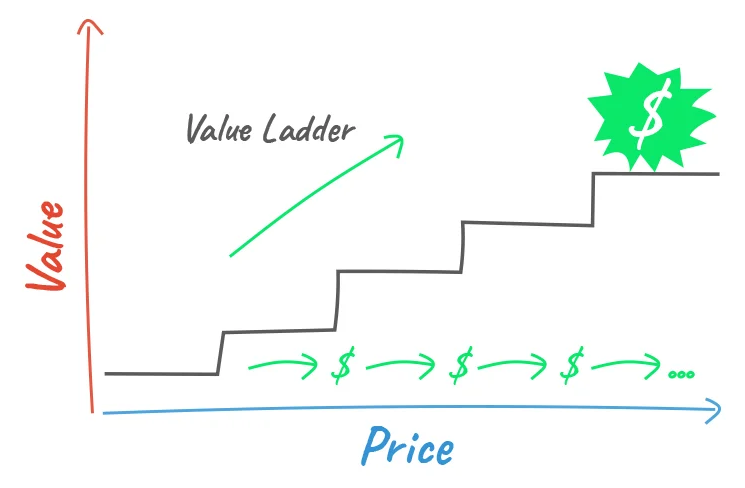
Essentially, the Value Ladder is a visual way of moving a lead through increasingly valuable offerings.
It might start with a free or low-cost entry offer, then progress through mid-tier products, all the way up to a big-ticket item.
For example, if you sell learning products, your Value Ladder might look like this:
- Free cheat sheet
- $10 ebook
- $100 Mini-course
- $350 Full course
- $1,000 One-on-one coaching and mentorship
This concept is designed to (supposedly) build trust and faith in your expertise by providing increasing value at each step (or rung).
The more a customer progresses up the ladder, the more they trust in your brand and the more receptive they will be to your high-priced offers.
That’s the idea, anyway.
How Do You Use It?
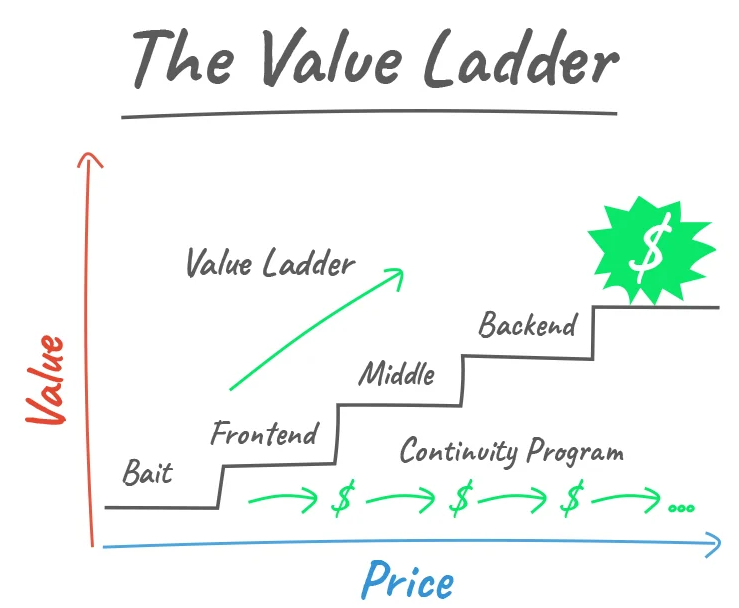
You can use the Value Ladder when mapping out any type of customer journey.
You start by learning everything about your target market. You can’t build a Value Ladder (or know what to offer them) if you don’t know what makes your audience tick.
Next, outline your offers.
There are no hard rules when it comes to the number of rungs on your ladder; it all depends on what your offers consist of. However, each Value Ladder generally has five main stages:
- Bait: What attracts individuals to your offer? It must be free yet valuable to the individual.
- Front End: At this point, you transform the individual into a paying customer by providing an irresistible yet heavily discounted offer, such as buy-one-get-one-free or 70% off.
- Middle: You’ve now given away a lot of free expertise. It’s time for your customers to put a bit of extra faith in you. This offer should be the main product. It’s neither discounted nor premium—the middle-ground, if you will.
- Back End: Customers who love your products will commit to you and move to this stage. This is the moment where you can provide a more expensive and more valuable offer.
- The Peak: This is your highest-priced offer, and ideally, it’s the point you’d like all your customers to reach. This should be your most premium product and the one that gives the most value.

Russell Brunson’s Macro Value Ladder for ClickFunnels
Then, choose your ladder type. Russell talks specifically about two types of Value Ladder:
- The Macro Value Ladder maps out the ecosystem of what your business offers. In other words, all products and services are listed in order of increasing value.
- The Micro Value Ladder focuses on specific offers, otherwise known as a sales funnel. Therefore, you might have a Micro Value Ladder for each component of your Macro Value Ladder.
So, a Macro Value Ladder will define your products and services in this order:
- Free
- Entry-level
- Mid-tier
- Premium

Russell Brunson’s Micro Value Ladder for Dotcom Secrets
When creating a micro-offer (funnel), you map out steps that contain multiple offers. So, it could look something like this:
- Free webinar or download
- One-time offer
- Order bump
- Upsell (or downsell)
Finally, once you have your Value Ladder mapped out, the idea is to hone in on one area and pick a starting place. This can be any stage of the ladder (front-end, middle, etc.); it just needs to make sense for what you’re trying to achieve.
For instance, a new business might start on the lower rungs to attract new customers, while an established business might focus on scaling its high-ticket offerings.
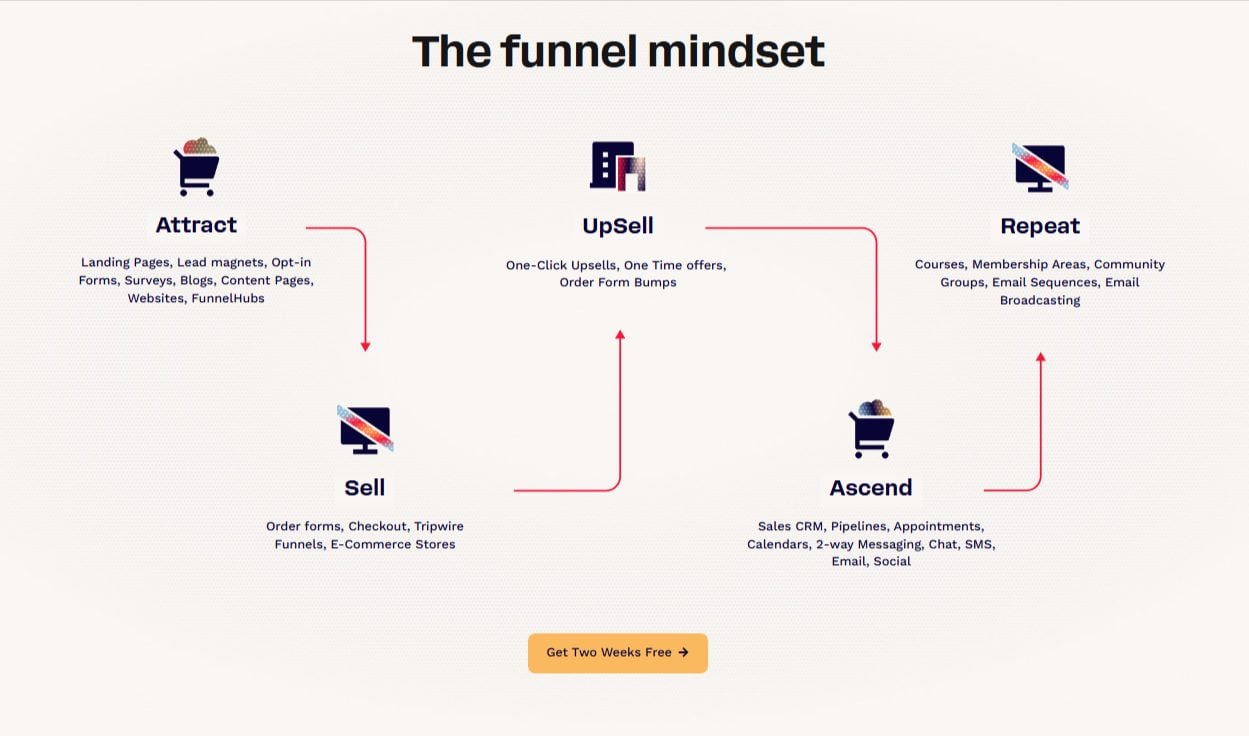
Next, it’s all about building a funnel to fulfill that step.
After all, this is Russell Brunson’s thing, and everything he does always comes down to a funnel.
Finally, once you’ve scaled, you can move on to concentrating on the next part of the ladder, and so on until…congratulations! You’re a millionaire! Maybe.
Where Can You Apply It?

The Value Ladder works best for digital products and services. It’s less ideal for physical products where customers are looking for a one-time solution, such as buying a new pair of shoes.
With that in mind, the Value Ladder is particularly effective for:
- Online coaching and mentorships
- Selling online courses and learning products
- Service-based businesses like consulting or content creation
- SaaS products (to a certain degree)
What Are Its Strengths?

For me, the biggest strength of the Value Ladder is its ability to show a clear path to monetization. By using the framework, you can easily map out offers and use it to optimize customer value.
I do want to point out here that Russell stresses that you don’t need a complete Value Ladder to get started.
He recommends starting with a single offer and working on making it a success. When you’ve done that, you can then add the next rung of the ladder, and so on.
Starting with one offer removes the overwhelm of having to design multiple offers and makes it simple enough for anyone to get started.
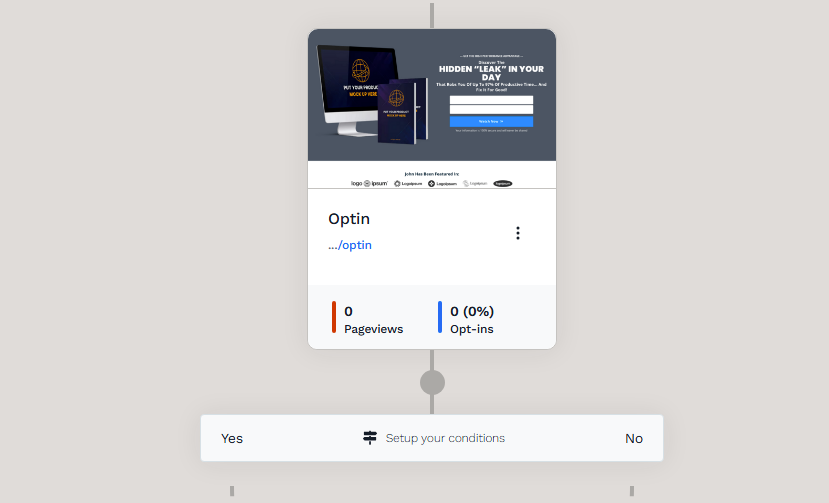
It’s also a good method to use for funnel optimization. Funnels, by nature, are linear in progression, so the Value Ladder fits very well in this case.
Lastly, if you rely on cold traffic, the Value Ladder can really help, thanks to its gradual progression. Rather than going in hard with a high-ticket offer, you can offer a path of low resistance and warm those cold leads up along the way.
Why the Value Ladder Can Feel Like a Dirty Sales Tactic
It’s About Linear Progression

The Value Ladder assumes that all customers are only willing to start with your lowest-cost offer before they progress to your higher-priced items.
You and I both know this doesn’t reflect reality.
Real buying behavior is non-linear, especially if the “main” product immediately solves their pain point or problem.
When you push people onto the lower rungs of the ladder rather than allowing them to step right onto the higher levels, you’re prioritizing your agenda over what the customer actually wants.
People don’t want to feel like they’re being led. They want autonomy and control over how and what they buy.
It Relies on Pressure
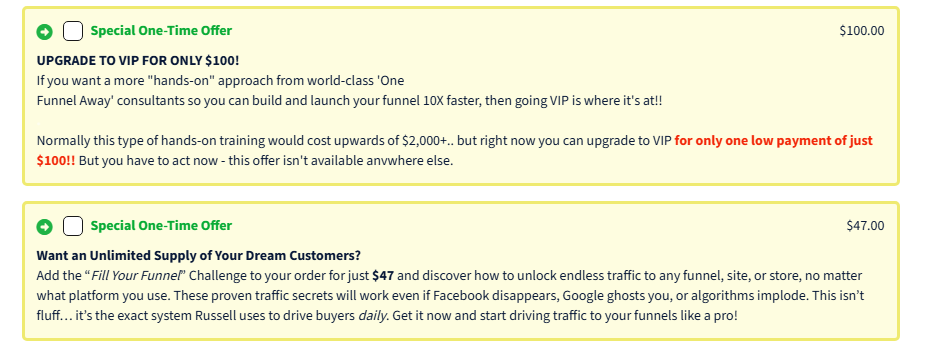
No one—I repeat, no one—likes a pushy salesperson, and that’s exactly what a sales funnel can feel like. This is particularly when they’re used to convey fake scarcity or urgency (“Quick! Buy now or it’s gone forever!”).
Aggressive funnels have been around since the dawn of the internet, and people have wised up to the psychological triggers they contain.
Ultimately, it erodes trust, which is exactly the opposite of what the Value Ladder is supposed to achieve.
There’s an art to making a sales funnel feel like anything but. However, it’s all too easy to end up with something that feels pushy and forceful.
Feels Manipulative
If your only goal is to move the customer through each step of the ladder, then all you’re doing is engineering the next upsell. It’s not a relationship, it’s purely transactional, and there’s something very hollow about that.
Trust is built by solving problems and addressing pain points. However, the ladder can feel like its job is to extract as much money from an individual as possible.
It might bring short-term wins from people who don’t initially see through your tactics, but they’ll disengage faster than a door-to-door salesperson gets the door slammed in their face.
Generates Customer Fatigue

If you’ve ever found yourself in a sales funnel containing endless upsells, downsells, left and right sells, then you can probably resonate with this point.
What started as a simple transaction can quickly descend into what feels like a money grab, and you get tired of it fast.
Sometimes (much of the time, actually), people just want to buy what they set out to buy. While the occasional “extra” isn’t particularly intrusive, having loads of them shoved in your face makes you want to log off and forget it altogether.
Alternative (and Better) Frameworks to Consider
Look, I’m not saying that the Value Ladder is bad. But it does rely on a certain type of sales tactic that not everyone will love.
If you’re wondering what I mean, go look up any of ClickFunnels or Russell Brunson’s sales and offer pages.
If you like what you see, great (because they follow the Value Ladder to a tee). If you don’t like the vibe, maybe one of the following frameworks will suit you better.
The Customer Success Flywheel
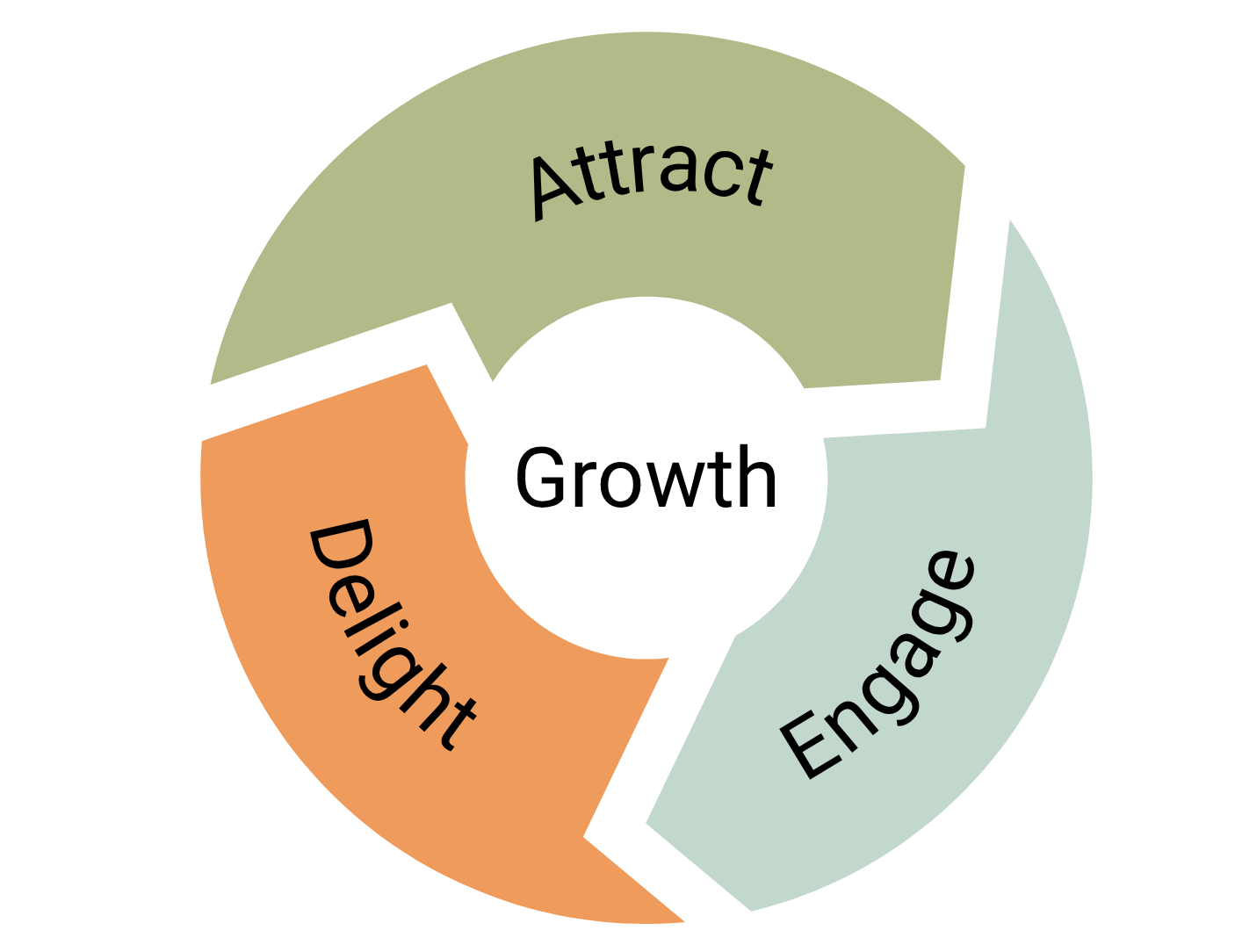
Championed by HubSpot, the Customer Success Flywheel is a refreshing alternative to the traditional sales funnel, focusing on building real, lasting customer relationships.
Think about it. When someone has exhausted all stages of your funnel (or Value Ladder), where do they have left to go? Nowhere, that’s where, except maybe to the next thing you can try and sell them.
In contrast, the flywheel follows a circular path with no end. If you concentrate on creating a great customer experience and delighting those who buy from you, they’ll not only come back, but they’ll also bring others along for the ride.
In a nutshell, the key principles of the flywheel are:
- Focusing on delight over upselling—happy customers will stay longer and spend more over time
- Using word-of-mouth and referrals as your growth tactic
- Keeping the momentum going (like a flywheel)—each happy customer builds energy that drives more engagement
Jobs-to-Be-Done

Jobs-to-be-Done focuses on outcomes and invites you to step into the customer’s world and ask, “What job are they hiring my product to do, or what goal does it need to achieve?”
When you know this, you can center your sales strategy around real-life needs rather than simply increasing revenue.
Doing so takes the focus away from the actual product and places it firmly on the customer’s needs and motivations for making the purchase.
This framework is excellent for understanding two key things:
- Aligning your offer with what the customer really wants or needs
- How to deliver a compelling customer experience
So, rather than resorting to pushy or aggressive sales tactics to convince the customer that they need your product, you deliver something they were looking for in the first place.
SPIN
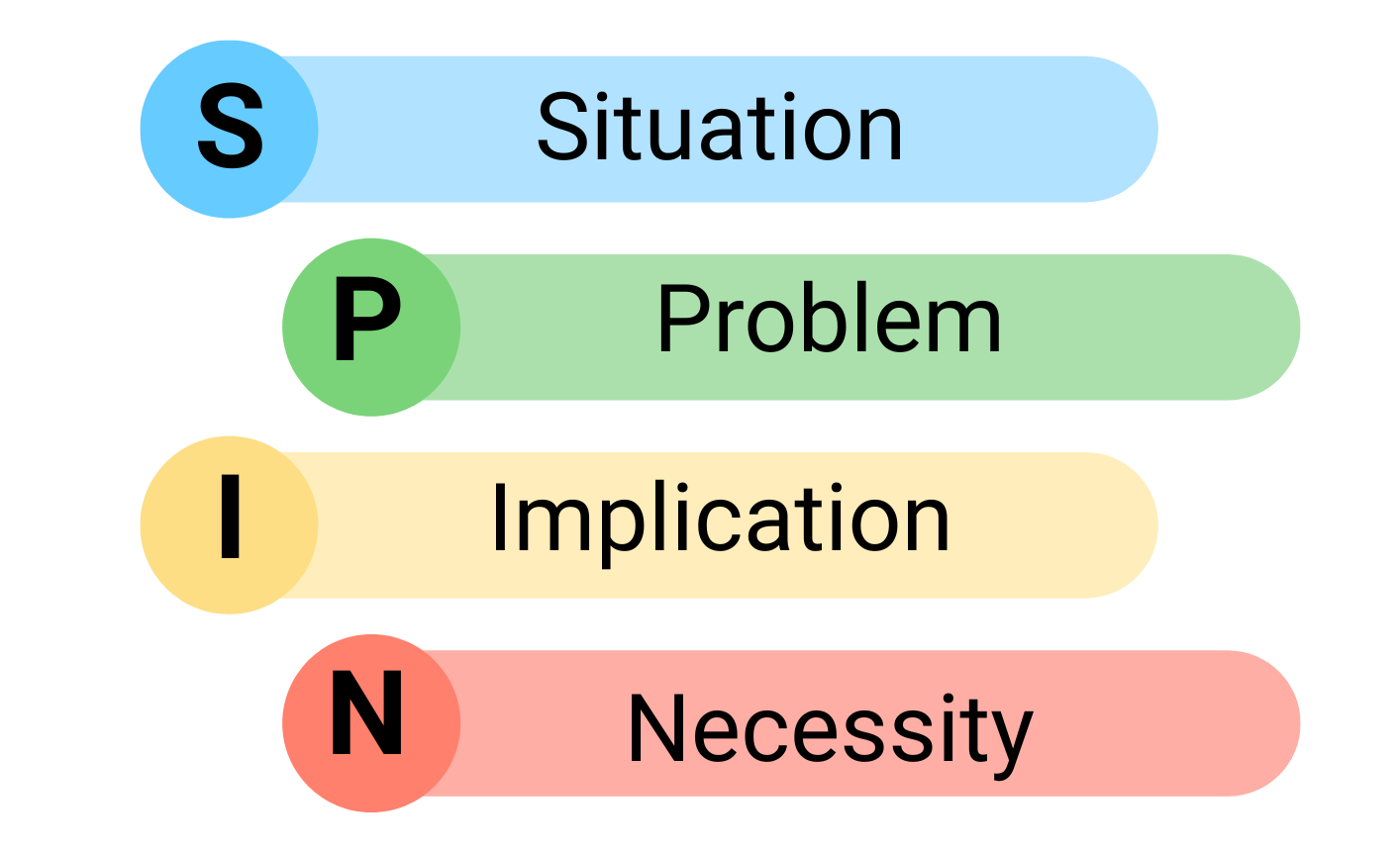
SPIN stands for Situation, Problem, Implication, Necessity.
It’s a consultative sales technique developed to help close complex sales cycles. However, it can be easily adapted for simpler sales processes, especially if you’re selling bespoke services, such as coaching.
As you can imagine, each letter of SPIN refers to a specific step in the process:
- Situation: This is where you take the time to understand the customer’s current situation. What are their goals, experiences, challenges, etc.? At this point, you are building rapport, not pushing products.
- Problem: Next, you delve into the problem or pain points the customer has. You will need to ask questions to uncover these, but it’s important not to come across as interrogative.
- Implication: Now, you transition into the potential consequences the customer will have if their problem isn’t addressed. At this point, you introduce the value of solving their problem and how your product or service can address it.
- Necessity: Finally, you guide the customer into taking a step forward with your offer. This could be by offering a free trial, an introductory session, or a mini-offer. This step then leads on to making the final sale of the main product.
The key skill here is to engage in a lot of active listening. The more the customer feels heard, the more rapport you will build with them and the more trust you will establish.
Like I said, this is an excellent method to use if you’re selling services, because they tend to be tailored to each customer. In this case, SPIN will be far more effective than the Value Ladder.
Frequently Asked Questions
Is Russell Brunson’s Value Ladder Specifically for Sales Funnels?
Yes, Russell Brunson’s Value Ladder is most commonly applied to sales funnels; however, it can be adapted for other online marketing methods that take a linear progression toward making sales.
Is Russell Brunson’s Value Ladder Worth Using?
The Value Ladder can be worth using if your business benefits from a structured, tiered approach to offers. If you use it ethically, the Value Ladder can still be effective. However, you might also want to consider other frameworks.




